NUR250 S1 2020 Assessment 1: Bronchitis Patient Case Analysis
VerifiedAdded on 2022/09/18
|11
|3122
|22
Homework Assignment
AI Summary
This assignment analyzes a case study of a 59-year-old female patient, Laura, admitted with bronchitis, a form of COPD. The analysis includes a discussion of the patient's medical history, symptoms, and risk factors, such as asthma and smoking. The assignment details a comprehensive nursing care plan addressing the risk of infection, impaired tissue perfusion, and knowledge deficit. It outlines nursing interventions, rationales, and evaluation criteria for each problem. Furthermore, the assignment covers patient education on inhaler use and controlled breathing techniques. It also discusses the pharmacology of prednisolone and ipratropium bromide, including their mechanisms of action, indications, and potential side effects. The document incorporates relevant research to support the clinical reasoning and nursing interventions.
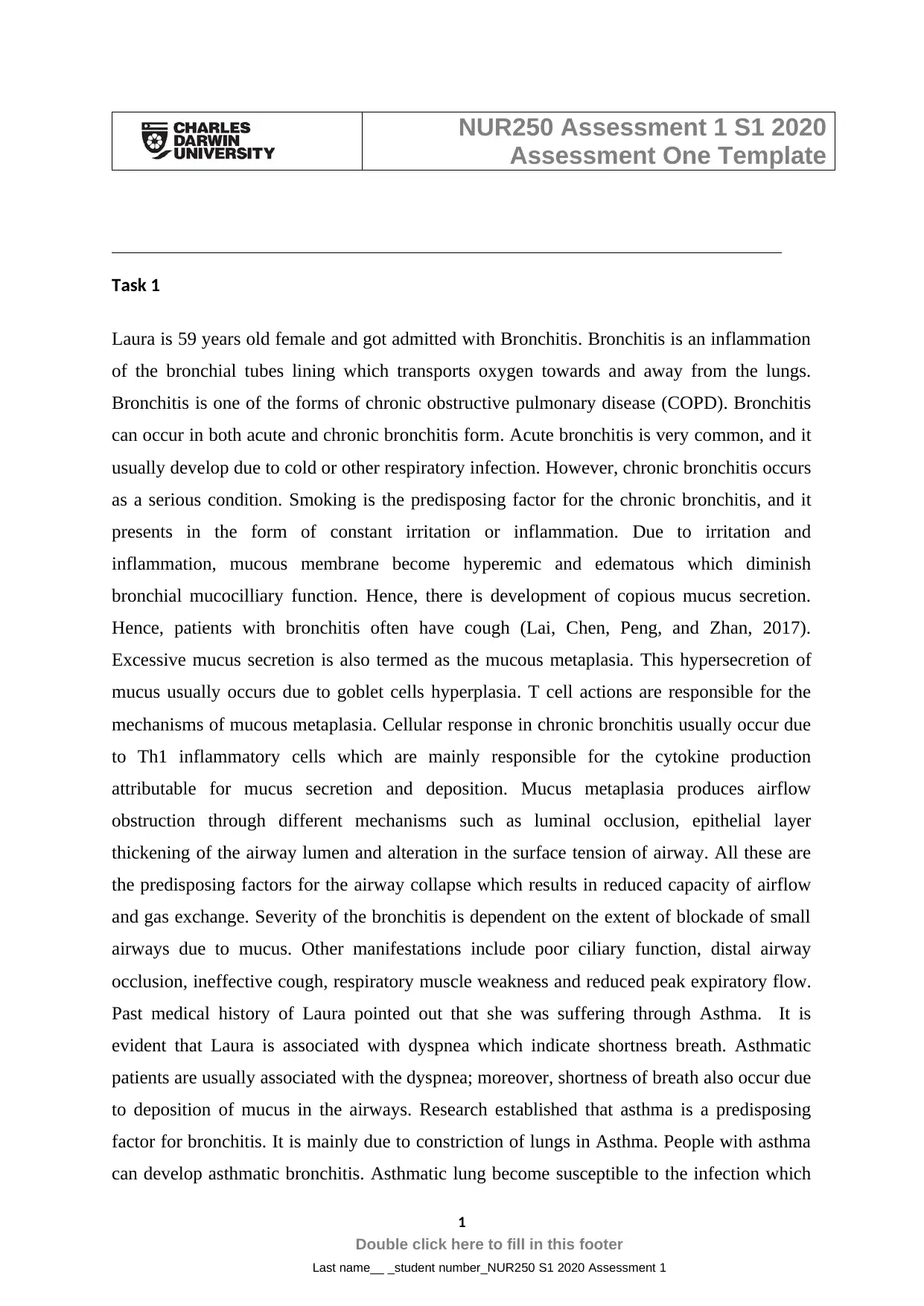
NUR250 Assessment 1 S1 2020
Assessment One Template
Task 1
Laura is 59 years old female and got admitted with Bronchitis. Bronchitis is an inflammation
of the bronchial tubes lining which transports oxygen towards and away from the lungs.
Bronchitis is one of the forms of chronic obstructive pulmonary disease (COPD). Bronchitis
can occur in both acute and chronic bronchitis form. Acute bronchitis is very common, and it
usually develop due to cold or other respiratory infection. However, chronic bronchitis occurs
as a serious condition. Smoking is the predisposing factor for the chronic bronchitis, and it
presents in the form of constant irritation or inflammation. Due to irritation and
inflammation, mucous membrane become hyperemic and edematous which diminish
bronchial mucocilliary function. Hence, there is development of copious mucus secretion.
Hence, patients with bronchitis often have cough (Lai, Chen, Peng, and Zhan, 2017).
Excessive mucus secretion is also termed as the mucous metaplasia. This hypersecretion of
mucus usually occurs due to goblet cells hyperplasia. T cell actions are responsible for the
mechanisms of mucous metaplasia. Cellular response in chronic bronchitis usually occur due
to Th1 inflammatory cells which are mainly responsible for the cytokine production
attributable for mucus secretion and deposition. Mucus metaplasia produces airflow
obstruction through different mechanisms such as luminal occlusion, epithelial layer
thickening of the airway lumen and alteration in the surface tension of airway. All these are
the predisposing factors for the airway collapse which results in reduced capacity of airflow
and gas exchange. Severity of the bronchitis is dependent on the extent of blockade of small
airways due to mucus. Other manifestations include poor ciliary function, distal airway
occlusion, ineffective cough, respiratory muscle weakness and reduced peak expiratory flow.
Past medical history of Laura pointed out that she was suffering through Asthma. It is
evident that Laura is associated with dyspnea which indicate shortness breath. Asthmatic
patients are usually associated with the dyspnea; moreover, shortness of breath also occur due
to deposition of mucus in the airways. Research established that asthma is a predisposing
factor for bronchitis. It is mainly due to constriction of lungs in Asthma. People with asthma
can develop asthmatic bronchitis. Asthmatic lung become susceptible to the infection which
1
Double click here to fill in this footer
Last name__ _student number_NUR250 S1 2020 Assessment 1
Assessment One Template
Task 1
Laura is 59 years old female and got admitted with Bronchitis. Bronchitis is an inflammation
of the bronchial tubes lining which transports oxygen towards and away from the lungs.
Bronchitis is one of the forms of chronic obstructive pulmonary disease (COPD). Bronchitis
can occur in both acute and chronic bronchitis form. Acute bronchitis is very common, and it
usually develop due to cold or other respiratory infection. However, chronic bronchitis occurs
as a serious condition. Smoking is the predisposing factor for the chronic bronchitis, and it
presents in the form of constant irritation or inflammation. Due to irritation and
inflammation, mucous membrane become hyperemic and edematous which diminish
bronchial mucocilliary function. Hence, there is development of copious mucus secretion.
Hence, patients with bronchitis often have cough (Lai, Chen, Peng, and Zhan, 2017).
Excessive mucus secretion is also termed as the mucous metaplasia. This hypersecretion of
mucus usually occurs due to goblet cells hyperplasia. T cell actions are responsible for the
mechanisms of mucous metaplasia. Cellular response in chronic bronchitis usually occur due
to Th1 inflammatory cells which are mainly responsible for the cytokine production
attributable for mucus secretion and deposition. Mucus metaplasia produces airflow
obstruction through different mechanisms such as luminal occlusion, epithelial layer
thickening of the airway lumen and alteration in the surface tension of airway. All these are
the predisposing factors for the airway collapse which results in reduced capacity of airflow
and gas exchange. Severity of the bronchitis is dependent on the extent of blockade of small
airways due to mucus. Other manifestations include poor ciliary function, distal airway
occlusion, ineffective cough, respiratory muscle weakness and reduced peak expiratory flow.
Past medical history of Laura pointed out that she was suffering through Asthma. It is
evident that Laura is associated with dyspnea which indicate shortness breath. Asthmatic
patients are usually associated with the dyspnea; moreover, shortness of breath also occur due
to deposition of mucus in the airways. Research established that asthma is a predisposing
factor for bronchitis. It is mainly due to constriction of lungs in Asthma. People with asthma
can develop asthmatic bronchitis. Asthmatic lung become susceptible to the infection which
1
Double click here to fill in this footer
Last name__ _student number_NUR250 S1 2020 Assessment 1
Paraphrase This Document
Need a fresh take? Get an instant paraphrase of this document with our AI Paraphraser
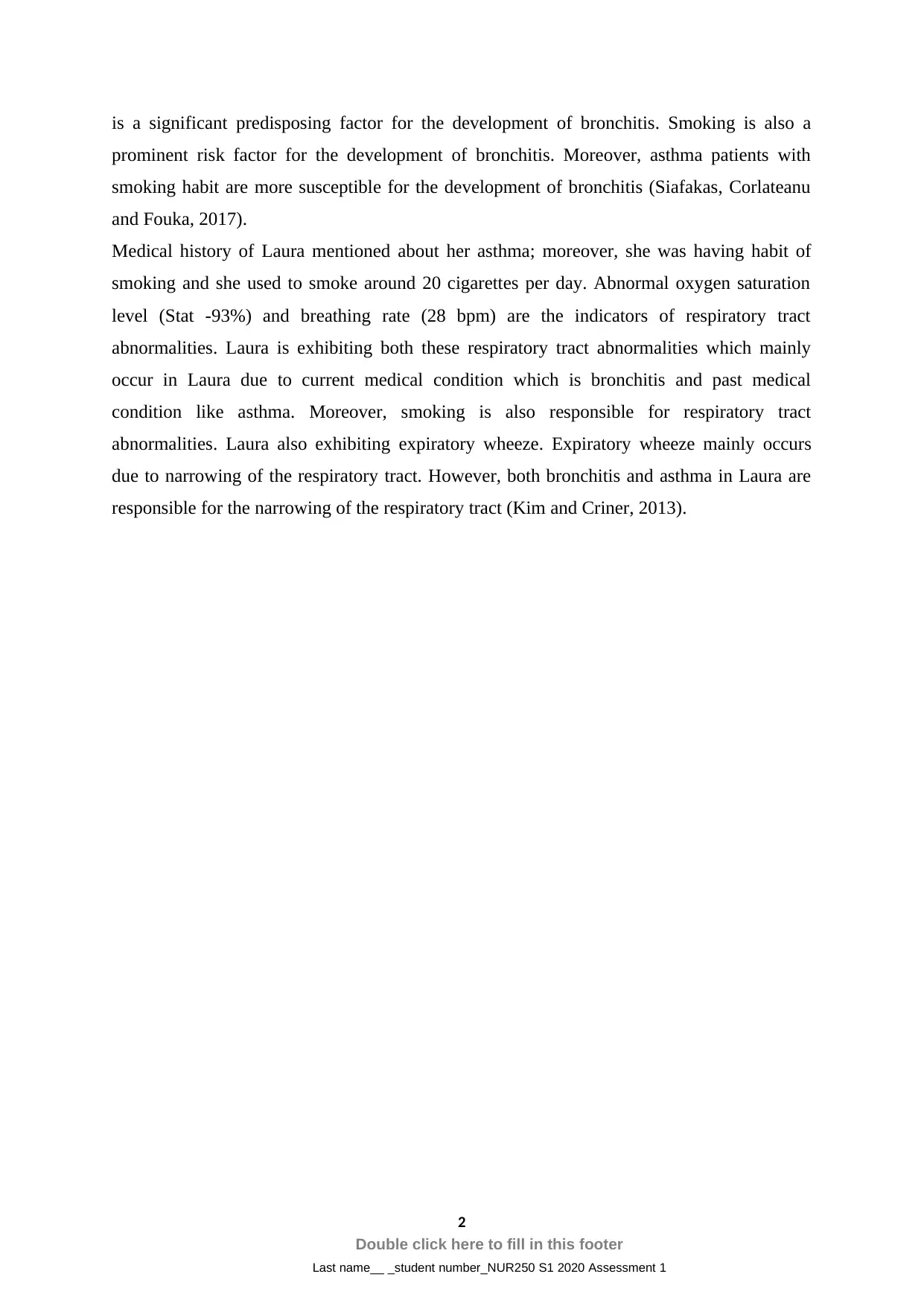
is a significant predisposing factor for the development of bronchitis. Smoking is also a
prominent risk factor for the development of bronchitis. Moreover, asthma patients with
smoking habit are more susceptible for the development of bronchitis (Siafakas, Corlateanu
and Fouka, 2017).
Medical history of Laura mentioned about her asthma; moreover, she was having habit of
smoking and she used to smoke around 20 cigarettes per day. Abnormal oxygen saturation
level (Stat -93%) and breathing rate (28 bpm) are the indicators of respiratory tract
abnormalities. Laura is exhibiting both these respiratory tract abnormalities which mainly
occur in Laura due to current medical condition which is bronchitis and past medical
condition like asthma. Moreover, smoking is also responsible for respiratory tract
abnormalities. Laura also exhibiting expiratory wheeze. Expiratory wheeze mainly occurs
due to narrowing of the respiratory tract. However, both bronchitis and asthma in Laura are
responsible for the narrowing of the respiratory tract (Kim and Criner, 2013).
2
Double click here to fill in this footer
Last name__ _student number_NUR250 S1 2020 Assessment 1
prominent risk factor for the development of bronchitis. Moreover, asthma patients with
smoking habit are more susceptible for the development of bronchitis (Siafakas, Corlateanu
and Fouka, 2017).
Medical history of Laura mentioned about her asthma; moreover, she was having habit of
smoking and she used to smoke around 20 cigarettes per day. Abnormal oxygen saturation
level (Stat -93%) and breathing rate (28 bpm) are the indicators of respiratory tract
abnormalities. Laura is exhibiting both these respiratory tract abnormalities which mainly
occur in Laura due to current medical condition which is bronchitis and past medical
condition like asthma. Moreover, smoking is also responsible for respiratory tract
abnormalities. Laura also exhibiting expiratory wheeze. Expiratory wheeze mainly occurs
due to narrowing of the respiratory tract. However, both bronchitis and asthma in Laura are
responsible for the narrowing of the respiratory tract (Kim and Criner, 2013).
2
Double click here to fill in this footer
Last name__ _student number_NUR250 S1 2020 Assessment 1
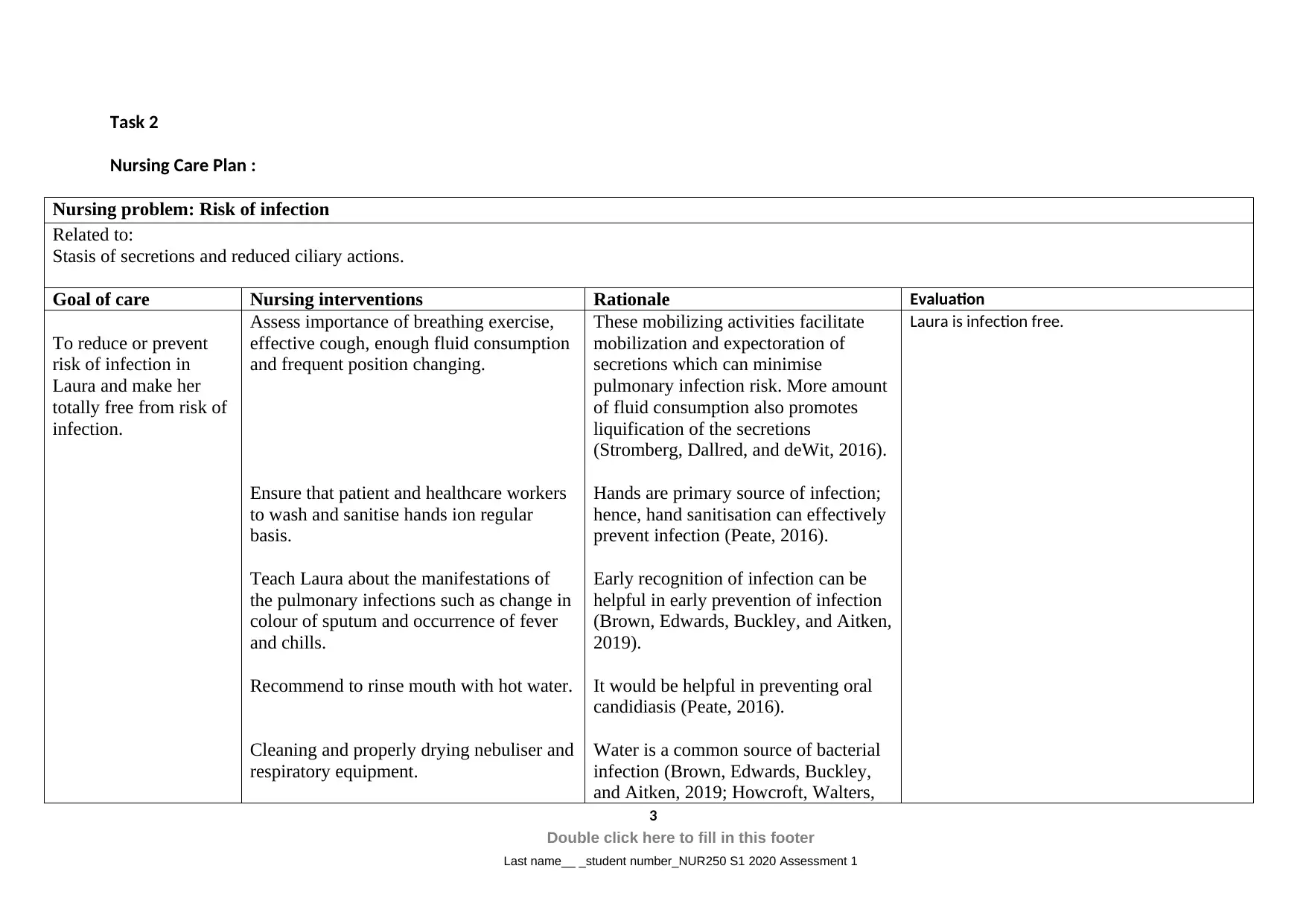
Task 2
Nursing Care Plan :
Nursing problem: Risk of infection
Related to:
Stasis of secretions and reduced ciliary actions.
Goal of care Nursing interventions Rationale Evaluation
To reduce or prevent
risk of infection in
Laura and make her
totally free from risk of
infection.
Assess importance of breathing exercise,
effective cough, enough fluid consumption
and frequent position changing.
Ensure that patient and healthcare workers
to wash and sanitise hands ion regular
basis.
Teach Laura about the manifestations of
the pulmonary infections such as change in
colour of sputum and occurrence of fever
and chills.
Recommend to rinse mouth with hot water.
Cleaning and properly drying nebuliser and
respiratory equipment.
These mobilizing activities facilitate
mobilization and expectoration of
secretions which can minimise
pulmonary infection risk. More amount
of fluid consumption also promotes
liquification of the secretions
(Stromberg, Dallred, and deWit, 2016).
Hands are primary source of infection;
hence, hand sanitisation can effectively
prevent infection (Peate, 2016).
Early recognition of infection can be
helpful in early prevention of infection
(Brown, Edwards, Buckley, and Aitken,
2019).
It would be helpful in preventing oral
candidiasis (Peate, 2016).
Water is a common source of bacterial
infection (Brown, Edwards, Buckley,
and Aitken, 2019; Howcroft, Walters,
Laura is infection free.
3
Double click here to fill in this footer
Last name__ _student number_NUR250 S1 2020 Assessment 1
Nursing Care Plan :
Nursing problem: Risk of infection
Related to:
Stasis of secretions and reduced ciliary actions.
Goal of care Nursing interventions Rationale Evaluation
To reduce or prevent
risk of infection in
Laura and make her
totally free from risk of
infection.
Assess importance of breathing exercise,
effective cough, enough fluid consumption
and frequent position changing.
Ensure that patient and healthcare workers
to wash and sanitise hands ion regular
basis.
Teach Laura about the manifestations of
the pulmonary infections such as change in
colour of sputum and occurrence of fever
and chills.
Recommend to rinse mouth with hot water.
Cleaning and properly drying nebuliser and
respiratory equipment.
These mobilizing activities facilitate
mobilization and expectoration of
secretions which can minimise
pulmonary infection risk. More amount
of fluid consumption also promotes
liquification of the secretions
(Stromberg, Dallred, and deWit, 2016).
Hands are primary source of infection;
hence, hand sanitisation can effectively
prevent infection (Peate, 2016).
Early recognition of infection can be
helpful in early prevention of infection
(Brown, Edwards, Buckley, and Aitken,
2019).
It would be helpful in preventing oral
candidiasis (Peate, 2016).
Water is a common source of bacterial
infection (Brown, Edwards, Buckley,
and Aitken, 2019; Howcroft, Walters,
Laura is infection free.
3
Double click here to fill in this footer
Last name__ _student number_NUR250 S1 2020 Assessment 1
⊘ This is a preview!⊘
Do you want full access?
Subscribe today to unlock all pages.

Trusted by 1+ million students worldwide
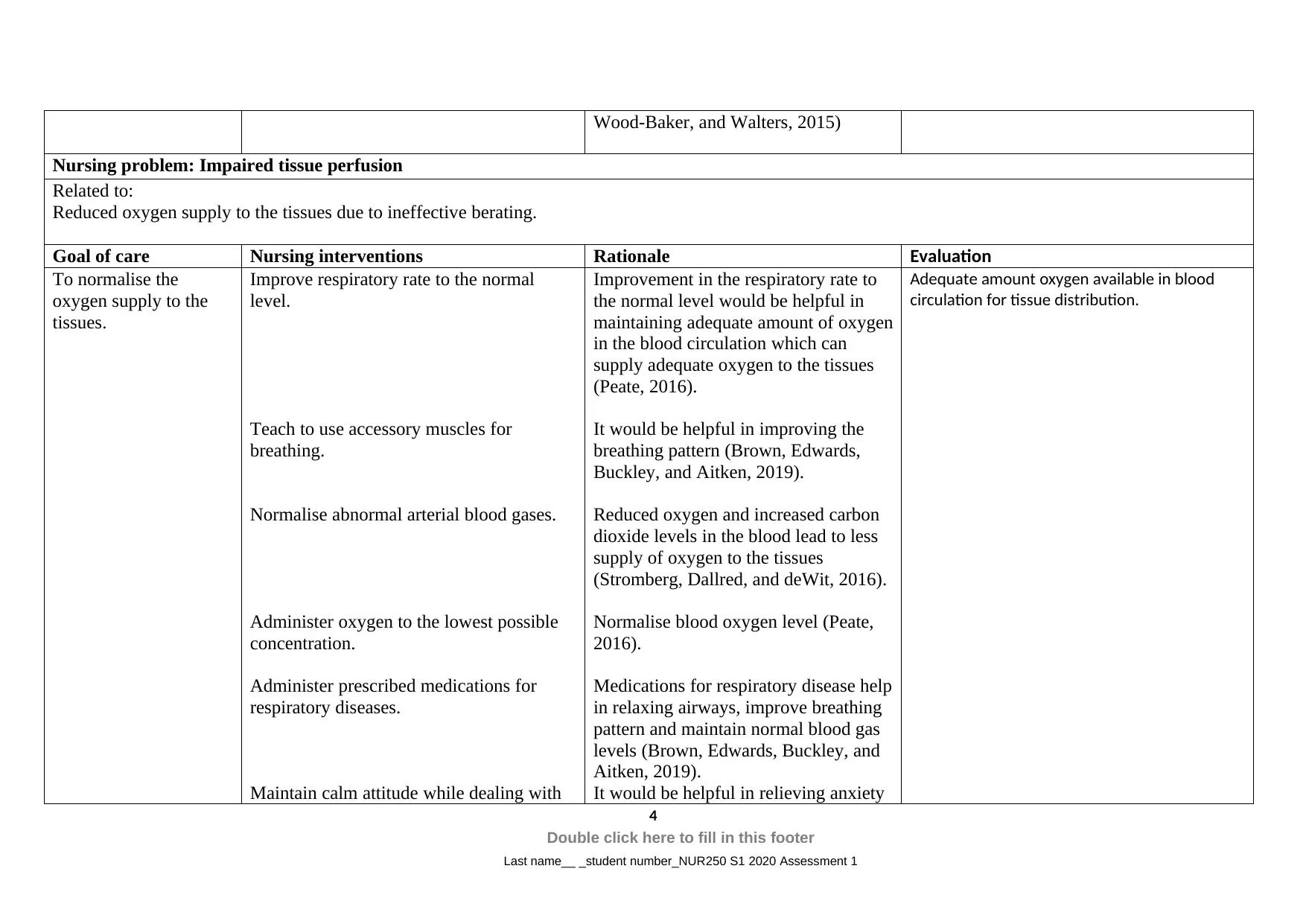
Wood-Baker, and Walters, 2015)
Nursing problem: Impaired tissue perfusion
Related to:
Reduced oxygen supply to the tissues due to ineffective berating.
Goal of care Nursing interventions Rationale Evaluation
To normalise the
oxygen supply to the
tissues.
Improve respiratory rate to the normal
level.
Teach to use accessory muscles for
breathing.
Normalise abnormal arterial blood gases.
Administer oxygen to the lowest possible
concentration.
Administer prescribed medications for
respiratory diseases.
Maintain calm attitude while dealing with
Improvement in the respiratory rate to
the normal level would be helpful in
maintaining adequate amount of oxygen
in the blood circulation which can
supply adequate oxygen to the tissues
(Peate, 2016).
It would be helpful in improving the
breathing pattern (Brown, Edwards,
Buckley, and Aitken, 2019).
Reduced oxygen and increased carbon
dioxide levels in the blood lead to less
supply of oxygen to the tissues
(Stromberg, Dallred, and deWit, 2016).
Normalise blood oxygen level (Peate,
2016).
Medications for respiratory disease help
in relaxing airways, improve breathing
pattern and maintain normal blood gas
levels (Brown, Edwards, Buckley, and
Aitken, 2019).
It would be helpful in relieving anxiety
Adequate amount oxygen available in blood
circulation for tissue distribution.
4
Double click here to fill in this footer
Last name__ _student number_NUR250 S1 2020 Assessment 1
Nursing problem: Impaired tissue perfusion
Related to:
Reduced oxygen supply to the tissues due to ineffective berating.
Goal of care Nursing interventions Rationale Evaluation
To normalise the
oxygen supply to the
tissues.
Improve respiratory rate to the normal
level.
Teach to use accessory muscles for
breathing.
Normalise abnormal arterial blood gases.
Administer oxygen to the lowest possible
concentration.
Administer prescribed medications for
respiratory diseases.
Maintain calm attitude while dealing with
Improvement in the respiratory rate to
the normal level would be helpful in
maintaining adequate amount of oxygen
in the blood circulation which can
supply adequate oxygen to the tissues
(Peate, 2016).
It would be helpful in improving the
breathing pattern (Brown, Edwards,
Buckley, and Aitken, 2019).
Reduced oxygen and increased carbon
dioxide levels in the blood lead to less
supply of oxygen to the tissues
(Stromberg, Dallred, and deWit, 2016).
Normalise blood oxygen level (Peate,
2016).
Medications for respiratory disease help
in relaxing airways, improve breathing
pattern and maintain normal blood gas
levels (Brown, Edwards, Buckley, and
Aitken, 2019).
It would be helpful in relieving anxiety
Adequate amount oxygen available in blood
circulation for tissue distribution.
4
Double click here to fill in this footer
Last name__ _student number_NUR250 S1 2020 Assessment 1
Paraphrase This Document
Need a fresh take? Get an instant paraphrase of this document with our AI Paraphraser
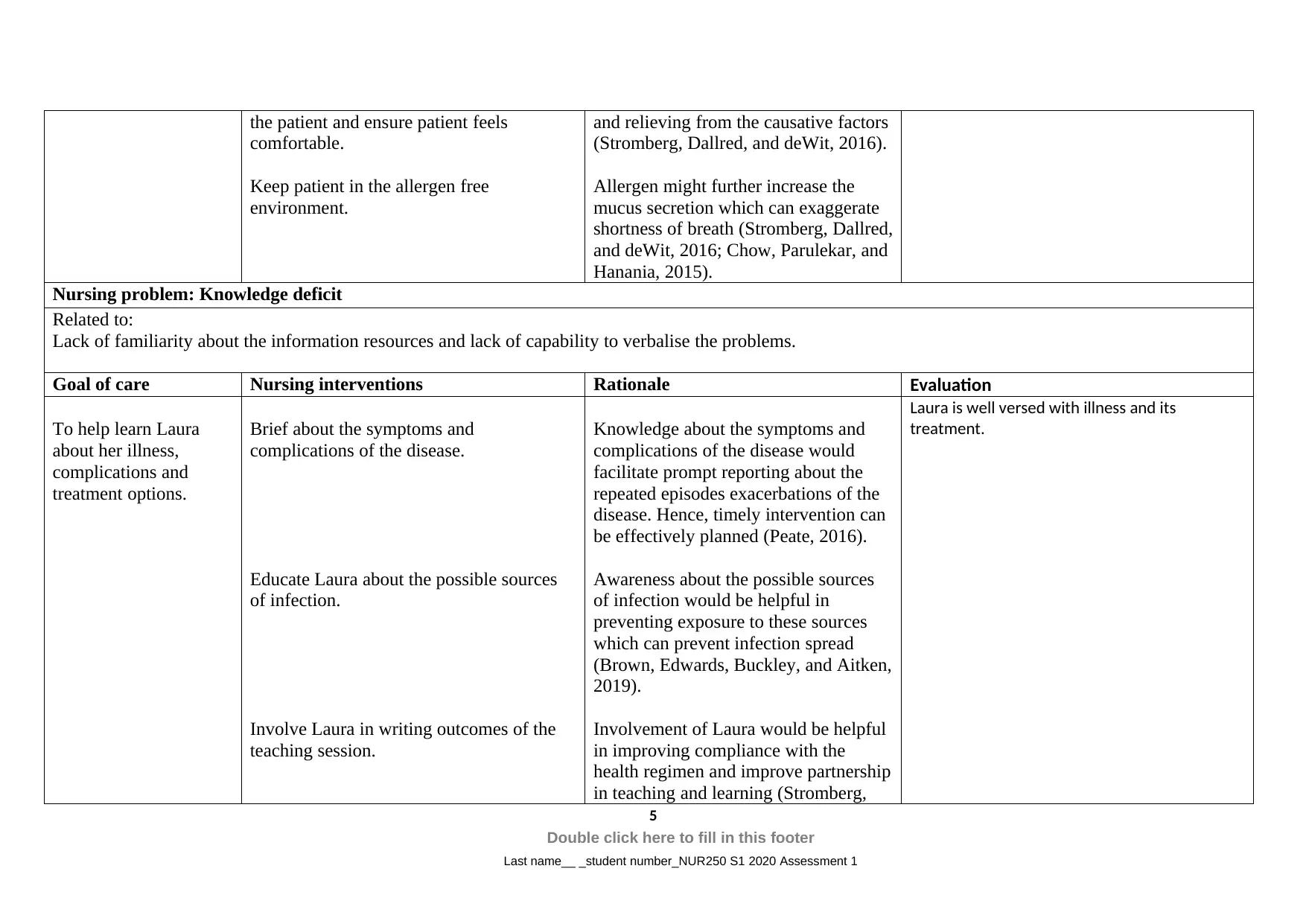
the patient and ensure patient feels
comfortable.
Keep patient in the allergen free
environment.
and relieving from the causative factors
(Stromberg, Dallred, and deWit, 2016).
Allergen might further increase the
mucus secretion which can exaggerate
shortness of breath (Stromberg, Dallred,
and deWit, 2016; Chow, Parulekar, and
Hanania, 2015).
Nursing problem: Knowledge deficit
Related to:
Lack of familiarity about the information resources and lack of capability to verbalise the problems.
Goal of care Nursing interventions Rationale Evaluation
To help learn Laura
about her illness,
complications and
treatment options.
Brief about the symptoms and
complications of the disease.
Educate Laura about the possible sources
of infection.
Involve Laura in writing outcomes of the
teaching session.
Knowledge about the symptoms and
complications of the disease would
facilitate prompt reporting about the
repeated episodes exacerbations of the
disease. Hence, timely intervention can
be effectively planned (Peate, 2016).
Awareness about the possible sources
of infection would be helpful in
preventing exposure to these sources
which can prevent infection spread
(Brown, Edwards, Buckley, and Aitken,
2019).
Involvement of Laura would be helpful
in improving compliance with the
health regimen and improve partnership
in teaching and learning (Stromberg,
Laura is well versed with illness and its
treatment.
5
Double click here to fill in this footer
Last name__ _student number_NUR250 S1 2020 Assessment 1
comfortable.
Keep patient in the allergen free
environment.
and relieving from the causative factors
(Stromberg, Dallred, and deWit, 2016).
Allergen might further increase the
mucus secretion which can exaggerate
shortness of breath (Stromberg, Dallred,
and deWit, 2016; Chow, Parulekar, and
Hanania, 2015).
Nursing problem: Knowledge deficit
Related to:
Lack of familiarity about the information resources and lack of capability to verbalise the problems.
Goal of care Nursing interventions Rationale Evaluation
To help learn Laura
about her illness,
complications and
treatment options.
Brief about the symptoms and
complications of the disease.
Educate Laura about the possible sources
of infection.
Involve Laura in writing outcomes of the
teaching session.
Knowledge about the symptoms and
complications of the disease would
facilitate prompt reporting about the
repeated episodes exacerbations of the
disease. Hence, timely intervention can
be effectively planned (Peate, 2016).
Awareness about the possible sources
of infection would be helpful in
preventing exposure to these sources
which can prevent infection spread
(Brown, Edwards, Buckley, and Aitken,
2019).
Involvement of Laura would be helpful
in improving compliance with the
health regimen and improve partnership
in teaching and learning (Stromberg,
Laura is well versed with illness and its
treatment.
5
Double click here to fill in this footer
Last name__ _student number_NUR250 S1 2020 Assessment 1

Incorporate audio-visual aids and different
technology aids for teaching the patients.
Dallred, and deWit, 2016).
It would be helpful in the faster
learning and long-lasting remembering
by the patients. Hence, patients can
implement the learned aspects after
discharge from the hospital also (Peate,
2016).
6
Double click here to fill in this footer
Last name__ _student number_NUR250 S1 2020 Assessment 1
technology aids for teaching the patients.
Dallred, and deWit, 2016).
It would be helpful in the faster
learning and long-lasting remembering
by the patients. Hence, patients can
implement the learned aspects after
discharge from the hospital also (Peate,
2016).
6
Double click here to fill in this footer
Last name__ _student number_NUR250 S1 2020 Assessment 1
⊘ This is a preview!⊘
Do you want full access?
Subscribe today to unlock all pages.

Trusted by 1+ million students worldwide

Task 3
Laura will be educated for use of inhaler and controlled breathing technique.
Education about the use of inhale is very important aspect for the patients with respiratory
diseases such as bronchitis and asthma. Moreover, educating Laura about the inhaler use at
the time of discharge could be more beneficial because she can use inhaler at home without
physical presence of healthcare professionals. In few cases, there are chances that acute
exacerbations of bronchitis can occur. In such scenario, inhaler should be used on the
emergency mode. Most effective strategy to provide education about inhaler should be
through providing practical demonstration of use of inhaler. Practical demonstration for use of
inhaler should be evaluated for capability of Laura for accurate use of inhaler. Nurse should
ensure that Laura is able to actuate exact dose. Moreover, during practical demonstration
nurse should ensure that Laura is holding her breath for few seconds. It would be beneficial in
inhalation of exact quantity of medicine (Thistlethwaite, and McKimm, 2015). Nurse should
check the technique practiced by the Laura for certain time intervals to ensure consistency in
using inhaler. Moreover, nurse should use placebo inhaler to reduce chances of overdose to
Laura. While providing practical demonstration for use of inhaler; nurse should evaluate
different types of inhalers for Laura. It would be helpful in selecting most suitable inhaler for
Laura. It is essential to select most appropriate inhaler because most of the inhalers need
correct timing and appropriate inspiratory flow rate. Selection of most appropriate inhaler is
essential; since, it is beneficial in improving the compliance to the treatment (Howcroft,
Walters, Wood-Baker, and Walters, 2015; Thistlethwaite, and McKimm, 2015).
In addition to the pharmacological treatment, it is necessary to incorporate non-
pharmacological treatment for the patients with respiratory disease. Controlled breathing
exercise proved beneficial for patients with respiratory disease. Controlled breathing exercise
is essential for Laura because it incorporate slow and shallow breathing which facilitate
improvement in the shortness of breath. Breathing exercise proved useful in preventing
further deterioration of respiratory parameters. In Laura, RR and Stat are abnormal. In such
scenario, breathing exercise can be helpful in improving respiratory parameters. It is
necessary to incorporate the occupational health worker for providing breathing training to
Laura because this training should be incorporated to bring the complex multidimensional
behavioral change in Laura. Hence, it is essential to incorporate both instructional and
7
Double click here to fill in this footer
Last name__ _student number_NUR250 S1 2020 Assessment 1
Laura will be educated for use of inhaler and controlled breathing technique.
Education about the use of inhale is very important aspect for the patients with respiratory
diseases such as bronchitis and asthma. Moreover, educating Laura about the inhaler use at
the time of discharge could be more beneficial because she can use inhaler at home without
physical presence of healthcare professionals. In few cases, there are chances that acute
exacerbations of bronchitis can occur. In such scenario, inhaler should be used on the
emergency mode. Most effective strategy to provide education about inhaler should be
through providing practical demonstration of use of inhaler. Practical demonstration for use of
inhaler should be evaluated for capability of Laura for accurate use of inhaler. Nurse should
ensure that Laura is able to actuate exact dose. Moreover, during practical demonstration
nurse should ensure that Laura is holding her breath for few seconds. It would be beneficial in
inhalation of exact quantity of medicine (Thistlethwaite, and McKimm, 2015). Nurse should
check the technique practiced by the Laura for certain time intervals to ensure consistency in
using inhaler. Moreover, nurse should use placebo inhaler to reduce chances of overdose to
Laura. While providing practical demonstration for use of inhaler; nurse should evaluate
different types of inhalers for Laura. It would be helpful in selecting most suitable inhaler for
Laura. It is essential to select most appropriate inhaler because most of the inhalers need
correct timing and appropriate inspiratory flow rate. Selection of most appropriate inhaler is
essential; since, it is beneficial in improving the compliance to the treatment (Howcroft,
Walters, Wood-Baker, and Walters, 2015; Thistlethwaite, and McKimm, 2015).
In addition to the pharmacological treatment, it is necessary to incorporate non-
pharmacological treatment for the patients with respiratory disease. Controlled breathing
exercise proved beneficial for patients with respiratory disease. Controlled breathing exercise
is essential for Laura because it incorporate slow and shallow breathing which facilitate
improvement in the shortness of breath. Breathing exercise proved useful in preventing
further deterioration of respiratory parameters. In Laura, RR and Stat are abnormal. In such
scenario, breathing exercise can be helpful in improving respiratory parameters. It is
necessary to incorporate the occupational health worker for providing breathing training to
Laura because this training should be incorporated to bring the complex multidimensional
behavioral change in Laura. Hence, it is essential to incorporate both instructional and
7
Double click here to fill in this footer
Last name__ _student number_NUR250 S1 2020 Assessment 1
Paraphrase This Document
Need a fresh take? Get an instant paraphrase of this document with our AI Paraphraser
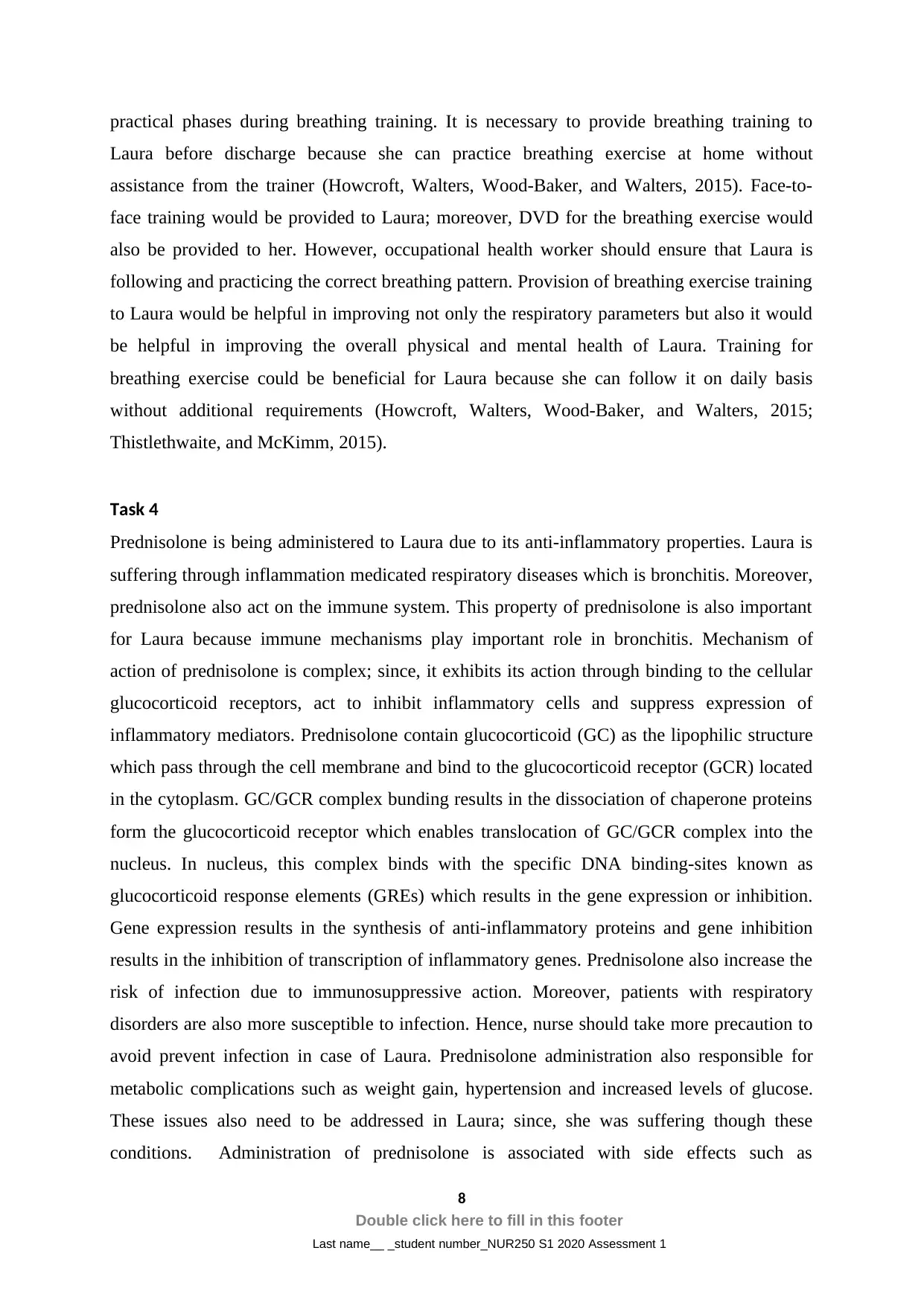
practical phases during breathing training. It is necessary to provide breathing training to
Laura before discharge because she can practice breathing exercise at home without
assistance from the trainer (Howcroft, Walters, Wood-Baker, and Walters, 2015). Face-to-
face training would be provided to Laura; moreover, DVD for the breathing exercise would
also be provided to her. However, occupational health worker should ensure that Laura is
following and practicing the correct breathing pattern. Provision of breathing exercise training
to Laura would be helpful in improving not only the respiratory parameters but also it would
be helpful in improving the overall physical and mental health of Laura. Training for
breathing exercise could be beneficial for Laura because she can follow it on daily basis
without additional requirements (Howcroft, Walters, Wood-Baker, and Walters, 2015;
Thistlethwaite, and McKimm, 2015).
Task 4
Prednisolone is being administered to Laura due to its anti-inflammatory properties. Laura is
suffering through inflammation medicated respiratory diseases which is bronchitis. Moreover,
prednisolone also act on the immune system. This property of prednisolone is also important
for Laura because immune mechanisms play important role in bronchitis. Mechanism of
action of prednisolone is complex; since, it exhibits its action through binding to the cellular
glucocorticoid receptors, act to inhibit inflammatory cells and suppress expression of
inflammatory mediators. Prednisolone contain glucocorticoid (GC) as the lipophilic structure
which pass through the cell membrane and bind to the glucocorticoid receptor (GCR) located
in the cytoplasm. GC/GCR complex bunding results in the dissociation of chaperone proteins
form the glucocorticoid receptor which enables translocation of GC/GCR complex into the
nucleus. In nucleus, this complex binds with the specific DNA binding-sites known as
glucocorticoid response elements (GREs) which results in the gene expression or inhibition.
Gene expression results in the synthesis of anti-inflammatory proteins and gene inhibition
results in the inhibition of transcription of inflammatory genes. Prednisolone also increase the
risk of infection due to immunosuppressive action. Moreover, patients with respiratory
disorders are also more susceptible to infection. Hence, nurse should take more precaution to
avoid prevent infection in case of Laura. Prednisolone administration also responsible for
metabolic complications such as weight gain, hypertension and increased levels of glucose.
These issues also need to be addressed in Laura; since, she was suffering though these
conditions. Administration of prednisolone is associated with side effects such as
8
Double click here to fill in this footer
Last name__ _student number_NUR250 S1 2020 Assessment 1
Laura before discharge because she can practice breathing exercise at home without
assistance from the trainer (Howcroft, Walters, Wood-Baker, and Walters, 2015). Face-to-
face training would be provided to Laura; moreover, DVD for the breathing exercise would
also be provided to her. However, occupational health worker should ensure that Laura is
following and practicing the correct breathing pattern. Provision of breathing exercise training
to Laura would be helpful in improving not only the respiratory parameters but also it would
be helpful in improving the overall physical and mental health of Laura. Training for
breathing exercise could be beneficial for Laura because she can follow it on daily basis
without additional requirements (Howcroft, Walters, Wood-Baker, and Walters, 2015;
Thistlethwaite, and McKimm, 2015).
Task 4
Prednisolone is being administered to Laura due to its anti-inflammatory properties. Laura is
suffering through inflammation medicated respiratory diseases which is bronchitis. Moreover,
prednisolone also act on the immune system. This property of prednisolone is also important
for Laura because immune mechanisms play important role in bronchitis. Mechanism of
action of prednisolone is complex; since, it exhibits its action through binding to the cellular
glucocorticoid receptors, act to inhibit inflammatory cells and suppress expression of
inflammatory mediators. Prednisolone contain glucocorticoid (GC) as the lipophilic structure
which pass through the cell membrane and bind to the glucocorticoid receptor (GCR) located
in the cytoplasm. GC/GCR complex bunding results in the dissociation of chaperone proteins
form the glucocorticoid receptor which enables translocation of GC/GCR complex into the
nucleus. In nucleus, this complex binds with the specific DNA binding-sites known as
glucocorticoid response elements (GREs) which results in the gene expression or inhibition.
Gene expression results in the synthesis of anti-inflammatory proteins and gene inhibition
results in the inhibition of transcription of inflammatory genes. Prednisolone also increase the
risk of infection due to immunosuppressive action. Moreover, patients with respiratory
disorders are also more susceptible to infection. Hence, nurse should take more precaution to
avoid prevent infection in case of Laura. Prednisolone administration also responsible for
metabolic complications such as weight gain, hypertension and increased levels of glucose.
These issues also need to be addressed in Laura; since, she was suffering though these
conditions. Administration of prednisolone is associated with side effects such as
8
Double click here to fill in this footer
Last name__ _student number_NUR250 S1 2020 Assessment 1

dermatological effects such as reddening of face, bruising or skin discoloration, skin rash and
impaired wound healing (Gilchrist, Ahmad, Batchelor, Marriott, and Lenney, 2016; Francis,
Smith, and Malkinson, 2015).
Ipratropium bromide is an anticholinergic and muscarinic receptor antagonist which act on the
bronchial smooth muscles. This drug is being administered for Laura for smooth muscle
relaxation and bronchodilation. These actions could be beneficial in improving the breathing
in Laura which mainly occur due to the constriction and narrowing of the respiratory tract. It
helps in opening the medium and large airways in the lungs and it is usually administered
through inhaler or nebulizer. It exhibits its action through unspecific blocked of the
muscarinic acetylcholine receptors which promote degradation of cyclic guanosine
monophosphate (cGMP) which results in the reduced intracellular concentration of cGMP.
cGMP act on the intracellular calcium which lead to reduced contractibility off smooth
muscle and inhibit bronchoconstriction and mucus secretion. Ipratropium does not diffuse in
the blood; hence, it does not produce systemic side effects. Moreover, ipratropium bromide
exhibits lesser side effects in comparison to other inhaled anticholinergic drugs. Side effects
such as dry mouth, sedation, skin flushing, tachycardia, acute angle-closure glaucoma, nausea,
palpitations and headache have been reported for ipratropium bromide. Urinary retention has
also been reported for ipratropium bromide. Stomach upset and constipation also might occur
due to ipratropium bromide. There are chances that sudden spasm and worsening of breathing
might occur immediately after its administration. Inflammation of the tissue lining the sinuses
can also occur due to repeated use of ipratropium bromide (Chow, Parulekar, and Hanania,
2015; Cheyne, Irvin-Sellers and White, 2015).
9
Double click here to fill in this footer
Last name__ _student number_NUR250 S1 2020 Assessment 1
impaired wound healing (Gilchrist, Ahmad, Batchelor, Marriott, and Lenney, 2016; Francis,
Smith, and Malkinson, 2015).
Ipratropium bromide is an anticholinergic and muscarinic receptor antagonist which act on the
bronchial smooth muscles. This drug is being administered for Laura for smooth muscle
relaxation and bronchodilation. These actions could be beneficial in improving the breathing
in Laura which mainly occur due to the constriction and narrowing of the respiratory tract. It
helps in opening the medium and large airways in the lungs and it is usually administered
through inhaler or nebulizer. It exhibits its action through unspecific blocked of the
muscarinic acetylcholine receptors which promote degradation of cyclic guanosine
monophosphate (cGMP) which results in the reduced intracellular concentration of cGMP.
cGMP act on the intracellular calcium which lead to reduced contractibility off smooth
muscle and inhibit bronchoconstriction and mucus secretion. Ipratropium does not diffuse in
the blood; hence, it does not produce systemic side effects. Moreover, ipratropium bromide
exhibits lesser side effects in comparison to other inhaled anticholinergic drugs. Side effects
such as dry mouth, sedation, skin flushing, tachycardia, acute angle-closure glaucoma, nausea,
palpitations and headache have been reported for ipratropium bromide. Urinary retention has
also been reported for ipratropium bromide. Stomach upset and constipation also might occur
due to ipratropium bromide. There are chances that sudden spasm and worsening of breathing
might occur immediately after its administration. Inflammation of the tissue lining the sinuses
can also occur due to repeated use of ipratropium bromide (Chow, Parulekar, and Hanania,
2015; Cheyne, Irvin-Sellers and White, 2015).
9
Double click here to fill in this footer
Last name__ _student number_NUR250 S1 2020 Assessment 1
⊘ This is a preview!⊘
Do you want full access?
Subscribe today to unlock all pages.

Trusted by 1+ million students worldwide

References
Brown, D., Edwards, H., Buckley, T., and Aitken, R. L. (2019). Lewis's Medical-Surgical
Nursing EBook: Assessment and Management of Clinical Problems. Chatswood,
NSW: Elsevier Australia.
Cheyne, L., Irvin-Sellers, M.J., and White, J. (2015). Tiotropium versus ipratropium bromide
for chronic obstructive pulmonary disease. Cochrane Database of Systematic Reviews,
22;(9):CD009552. doi: 10.1002/14651858.CD009552.
Chow, L., Parulekar, A.D., and Hanania, N.A. (2015). Hospital management of acute
exacerbations of chronic obstructive pulmonary disease. Journal of Hospital Medicine,
10(5); 328-39.
Francis, S., Smith, F., and Malkinson, J. (2015). Integrated Pharmacy Case Studies.
Pharmaceutical Press.
Gilchrist, F.J., Ahmad, A.N., Batchelor, H.K., Marriott, J.F., and Lenney, W. (2016). A
review of prednisolone prescribing for children with acute asthma in the UK. Journal
of Asthma, 53(6), 563-6.
Howcroft, M., Walters, E.H., Wood-Baker, R., and Walters, J.A. (2016). Action plans with
brief patient education for exacerbations in chronic obstructive pulmonary disease.
Cochrane Database of Systematic Reviews, 12:CD005074. doi:
10.1002/14651858.CD005074.
Kim, V., and Criner, G.J. (2013). Chronic bronchitis and chronic obstructive pulmonary
disease. American Journal of Respiratory and Critical Care Medicine, 187(3):228-
37Lai, K., Chen, R.,
LeMone, P., Burke, K. M., Bauldoff, G., Gubrud, P., Levett-Jones, T., Hales, M., …Reid-
Searl, K. Paula Marie Gubrud-Howe. Medical-surgical Nursing: Clinical Reasoning in
Patient Care. (3rd ed.). Melbourne, Victoria: Pearson Australia.
Levett-Jones, T. (2018). Clinical Reasoning: Learning to think like a nurse. Melbourne,
Victoria: Pearson Australia.
Peng, W., and Zhan, W. (1017). Non-asthmatic eosinophilic bronchitis and its relationship
with asthma. Pulmonary Pharmacology & Therapeutics, 47:66-71.
Peate, I. (2016). Medical-Surgical Nursing at a Glance. John Wiley & Sons. Oxford. UK.
Siafakas, N., Corlateanu, A., and Fouka, E. (2017). Phenotyping Before Starting
Treatment in COPD? Chronic obstructive pulmonary disease, 14(3):367-374.
Stromberg, H., Dallred, C., and deWit, S. C. (2016). Medical-Surgical Nursing - E-Book:
Concepts & Practice. Chatswood, NSW: Elsevier Australia.
Thistlethwaite, J., and McKimm, J. (2015). Health Care Professionalism at a Glance. John
Wiley & Sons.
Tiziani, A. (2017). Harvard’s Nursing Guide to Drugs. (10th ed.). Chatswood, NSW: Elsevier
Australia.
10
Double click here to fill in this footer
Last name__ _student number_NUR250 S1 2020 Assessment 1
Brown, D., Edwards, H., Buckley, T., and Aitken, R. L. (2019). Lewis's Medical-Surgical
Nursing EBook: Assessment and Management of Clinical Problems. Chatswood,
NSW: Elsevier Australia.
Cheyne, L., Irvin-Sellers, M.J., and White, J. (2015). Tiotropium versus ipratropium bromide
for chronic obstructive pulmonary disease. Cochrane Database of Systematic Reviews,
22;(9):CD009552. doi: 10.1002/14651858.CD009552.
Chow, L., Parulekar, A.D., and Hanania, N.A. (2015). Hospital management of acute
exacerbations of chronic obstructive pulmonary disease. Journal of Hospital Medicine,
10(5); 328-39.
Francis, S., Smith, F., and Malkinson, J. (2015). Integrated Pharmacy Case Studies.
Pharmaceutical Press.
Gilchrist, F.J., Ahmad, A.N., Batchelor, H.K., Marriott, J.F., and Lenney, W. (2016). A
review of prednisolone prescribing for children with acute asthma in the UK. Journal
of Asthma, 53(6), 563-6.
Howcroft, M., Walters, E.H., Wood-Baker, R., and Walters, J.A. (2016). Action plans with
brief patient education for exacerbations in chronic obstructive pulmonary disease.
Cochrane Database of Systematic Reviews, 12:CD005074. doi:
10.1002/14651858.CD005074.
Kim, V., and Criner, G.J. (2013). Chronic bronchitis and chronic obstructive pulmonary
disease. American Journal of Respiratory and Critical Care Medicine, 187(3):228-
37Lai, K., Chen, R.,
LeMone, P., Burke, K. M., Bauldoff, G., Gubrud, P., Levett-Jones, T., Hales, M., …Reid-
Searl, K. Paula Marie Gubrud-Howe. Medical-surgical Nursing: Clinical Reasoning in
Patient Care. (3rd ed.). Melbourne, Victoria: Pearson Australia.
Levett-Jones, T. (2018). Clinical Reasoning: Learning to think like a nurse. Melbourne,
Victoria: Pearson Australia.
Peng, W., and Zhan, W. (1017). Non-asthmatic eosinophilic bronchitis and its relationship
with asthma. Pulmonary Pharmacology & Therapeutics, 47:66-71.
Peate, I. (2016). Medical-Surgical Nursing at a Glance. John Wiley & Sons. Oxford. UK.
Siafakas, N., Corlateanu, A., and Fouka, E. (2017). Phenotyping Before Starting
Treatment in COPD? Chronic obstructive pulmonary disease, 14(3):367-374.
Stromberg, H., Dallred, C., and deWit, S. C. (2016). Medical-Surgical Nursing - E-Book:
Concepts & Practice. Chatswood, NSW: Elsevier Australia.
Thistlethwaite, J., and McKimm, J. (2015). Health Care Professionalism at a Glance. John
Wiley & Sons.
Tiziani, A. (2017). Harvard’s Nursing Guide to Drugs. (10th ed.). Chatswood, NSW: Elsevier
Australia.
10
Double click here to fill in this footer
Last name__ _student number_NUR250 S1 2020 Assessment 1
Paraphrase This Document
Need a fresh take? Get an instant paraphrase of this document with our AI Paraphraser

11
Double click here to fill in this footer
Last name__ _student number_NUR250 S1 2020 Assessment 1
Double click here to fill in this footer
Last name__ _student number_NUR250 S1 2020 Assessment 1
1 out of 11
Related Documents
Your All-in-One AI-Powered Toolkit for Academic Success.
+13062052269
info@desklib.com
Available 24*7 on WhatsApp / Email
![[object Object]](/_next/static/media/star-bottom.7253800d.svg)
Unlock your academic potential
Copyright © 2020–2025 A2Z Services. All Rights Reserved. Developed and managed by ZUCOL.





